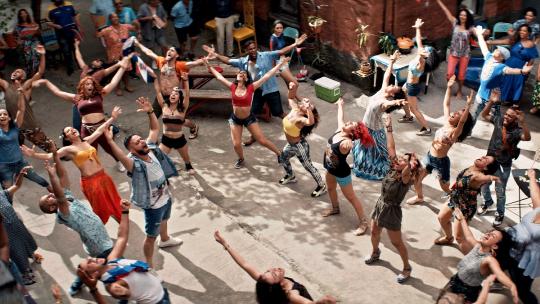 The film version of Lin-Manuel Miranda’s Broadway musical is a delightful expression of solidarity in a predominately Latino N.Y. neighborhood, with the group dancing especially enjoyable.
The film version of Lin-Manuel Miranda’s Broadway musical is a delightful expression of solidarity in a predominately Latino N.Y. neighborhood, with the group dancing especially enjoyable.
Have you seen In the Heights? This is the sort of question I feel compelled to ask after I’ve watched a film I consider amazing, and possibly of wide appeal. In the Heights is an adaptation of the Broadway musical of the same name with music and lyrics by Lin-Manuel Miranda, the genius behind Hamilton; and the book, as the non-singing part of a musical is called, by Quiara Alegria Hudes. The director is Jon M. Chu. It played on the big screen last year, but I wasn’t going out to see movies in theaters yet, so I saw it recently online. Oh, and another reason I’m curious if people have seen it is that in Hollywood terms, it was a flop, making significantly less money than it cost. This doesn’t usually surprise me, but In the Heights is not the usual type of film that I review.
The story concerns a group of people in the predominately Latino Washington Heights neighborhood in upper Manhattan. At the center are two couples. There’s Usnavi, played by Anthony Ramos, owner of a convenience store, or bodega as it’s called, yearning to go back to the Dominican Republic where he was born, and intending to buy his deceased father’s property there. He has a desperate crush on Vanessa, played by Melissa Barrera, who works in a beauty salon, but wants to get out of the neighborhood and become a fashion designer. Nina, played by Leslie Grace, is a brilliant young Puerto Rican woman returning to the Heights from her first year at Stanford. She felt alienated in that predominately Anglo environment, and would rather come back to live in the Heights, but her father (Jimmy Smits) expects and demands that she stay in school. Benny, played by Corey Hawkins, works for the father’s taxi company as a dispatcher, is best friends with Usnavi, and in love with Nina, supporting her in her desire to stay in New York. Around these people are many others: family, friends, and neighborhood characters.
The music is what I would call, in my relative ignorance, mainstream hip-hop inflected pop music. Anyway, this kind of music is not really my thing, but it’s a remarkable measure of quality, I think, that I find the songs lovely and quite pleasurable, both musically and lyrically. But the thing that knocked me out is the group dancing. Almost every number ends up involving the neighborhood, with a whole bunch of people singing and dancing, joyously and with great energy. The choreography, credited to Christopher Scott, is spectacular.
The film idealizes life in the neighborhood, which is something musicals do. It’s a heightened reality that we see and hear, and I found it utterly delightful. Being released during the pandemic probably hurt it more than anything, I imagine, although in general audiences today are not too crazy about musicals. Spielberg’s version of West Side Story, for instance, also didn’t get the box office that was expected.
Now, in this film there was also a bit of controversy when Washington Heights residents and others objected to the fact that, other than Benny, the important characters are not black. I don’t mean racially, but in terms of color. A vast majority of people in the Heights are black or dark brown in appearance. This complaint is understandable, especially from people who find themselves underrepresented in a film that is titled after their home. Manuel and the other filmmakers have admitted that it was an unintentional screw-up. Knowing nothing about Washington Heights, I absorbed its strong message of solidarity without a problem.
The real main character in this film is the community itself. To feel its power through outstanding songs and dance is exhilarating. If you like that feeling, In the Heights is a film for you.

A Finnish woman on a Russian train is aggravated by the man with which she’s forced to share a compartment: an insensitive young tough...

Gravity, directed by Alfonso Cuaron, steps away from the Star Trek / Star Wars type outer space film we’ve become used to, with their...

Agnès Varda’s film essay on gleaning explores the many implications of this ancient practice. Gleaning—gathering food left on the fields after harvest—is an ancient...